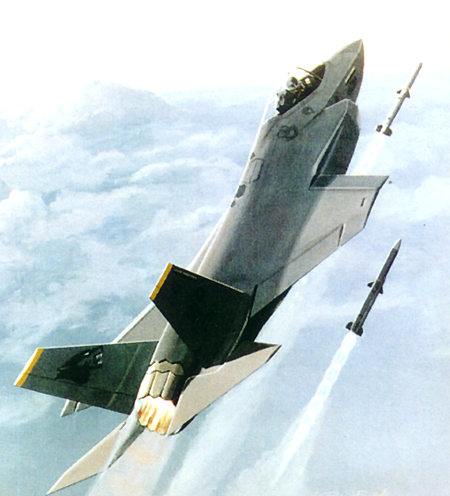The Joint Strike Fighter
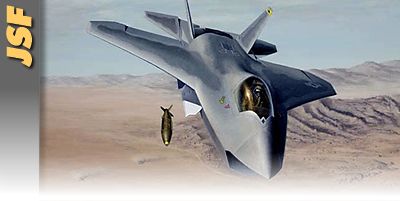

In December 1995, Boeing - in conjunction with Pratt & Whitney and Rolls-Royce - successfully completed
three months of engine and hover tests using a Large-Scale Powered Model (LSPM) at facilities
built by Boeing for the important tests.
Another of the major successful Boeing JSF design validations was completed in April 1996
in another Seattle-area Boeing test facility, the Indoor Radar Range, where Boeing engineers used
a full-scale model of the company's JSF in radar cross section (RCS) tests.
The RCS tests were so successful that Boeing needed only a few hours to validate the design instead of the weeks
originally scheduled to match results with detailed pre-test predictions.
The radar range tests strongly validated not only Boeing's unique design
but its basic analysis and test methodology as well.
By the summer of 1996 when Boeing submitted its JSF proposal to the customer,
Boeing had completed more than 11,800 hours of highly successful JSF-related tests in facilities on two continents.
Some of the major areas of the JSF test program included:
In November 1996, the U.S. Department of Defense awarded Boeing Aerospace and Lockheed Martin a four-year
contract for the concept demonstration phase of the Joint Strike Fighter program.
The contracts involve the building of demonstrator aircraft and refining the concepts for
three different configurations of next generation fighter aircraft.
The three variants are:
a conventional take-off and landing aircraft (CTOL) for the US Air Force
a carrier based aircraft for the US Navy; and a short take-off and vertical landing (STOVL)
aircraft for the US Marine Corps and the Royal Navy.
A 70 - 90% commonality is required for all variants (STOVL) variant.
Also in November, 1996, the Department of Defense (DoD) awarded The Boeing Company a 51-month contract
to proceed with the Joint Strike Fighter Concept Demonstration Program.
The award, announced by Secretary of Defense William Perry, culminated an effort begun two decades
ago with the goal of returning Boeing to the ranks of fighter aircraft manufacturers.
With its innovative design validated by more than 18,000 hours of aggressive simulation and testing,
Boeing has developed an affordable strike aircraft concept to meet the post-2000 needs of the U.S. Air Force,
Navy, Marines, United Kingdom Royal Navy and U.S. allies.
The Joint Strike Fighter is an affordable, multi-service aircraft for delivery after the year 2001 to these armed forces.
These armed forces will need as many as 3,000 Joint Strike Fighters
to replace several different aircraft in service today.
The requirement is for:
US Navy - first-day-of-war strike fighter to complement the F/A-18E/F (480 aircraft);
USAF - air-to-ground strike aircraft, replacing F-16 and complementing F-22 (1763);
USMC - STOVL strike fighter to replace F/A-18 and AV-8B (480);
UK RN - supersonic strike fighter to replace Sea Harriers (60).
JSF - SPECIFICATION
From the outset, Boeing has focused its Joint Strike Fighter (JSF) design concept
on the need for the aircraft to be affordable and to meet multi-service requirements.
Boeing incorporates affordability into its Joint Strike Fighter by identifying the common design space of each service
variant. Then, using a modular approach to the design, Boeing has developed specific variants
to meet the unique requirements of each service.
Because this approach generates such high part commonality among all the service variants,
they can be assembled on a single production line resulting in lower unit cost.
The Boeing JSF design exploits experience in modern composite materials and manufacturing processes
gained in the commercial 777 jetliner, the B-2 bomber and the F-22 air dominance fighter.
The unique expertise accrued in these key technologies significantly contributes
to the light weight and low cost of the Boeing JSF concept.
Although the Boeing concept stresses affordability, it does not sacrifice performance fundamental to mission
effectiveness. The Boeing JSF has maneuver capabilities equal to or better than the F-16 and F/A-18
and a combat radius and payload significantly better than the F-16 and F/A-18.
Recognizing the need to validate its innovative JSF design concept concurrent with engineering
and program milestones, Boeing conducted an unprecedented series of simulations and tests of its JSF design.
The JSF Program Office (formerly the Joint Advanced Strike Technology Program) based in Washington,
D.C. in early 1996, issued its Request For Proposals (RFP) for the concept demonstration phase of the program
that will lead to the building of approximately 3,000 Joint Strike Fighters in the next century.
The U.S. Air Force needs a low-cost, multi-role fighter to replace the F-16 and A-10
as they age in the early years of the 21st century.
The U.S. Navy needs a first-day-of-the-war survivable strike aircraft.
This aircraft must possess capabilities suitable to replace the A-6 which has already left the inventory.
The U.S. Marine Corps needs a Short Takeoff/Vertical Landing (STOVL) aircraft to replace its AV-8B and F/A-18.
The Marine Corps wants to transition to an all-STOVL strike force early in the 21st century.
The United Kingdom Royal Navy needs a STOVL aircraft to replace its aging Sea Harrier.
For the Marine Corps and the UK Royal Navy JSF variant, Boeing selected a direct-lift STOVL configuration
because of its light weight and proven application on the AV-8B Harrier.
This simple concept has the least impact on the basic airframe structure,
better lends itself to a common modular approach for all four services, and is the lowest cost solution.
The Boeing JSF concept not only meets the UK Harrier replacement needs, but may meet the requirements
for the UK Future Offensive Aircraft (FOA) as well.
Other allies have voiced interest in the JSF program and Boeing believes there will be
a substantial international market for the low-cost, high-performance strike aircraft.
Boeing unveiled not one - but both - of its X-32 Joint Strike Fighter concept demonstrators
at a ceremony honoring the Boeing JSF "One Team" of employees, suppliers and Defense Department customers
in Palmdale, Calif., on Dec. 14.
The X-32A is pictured at left; the X-32B, right.
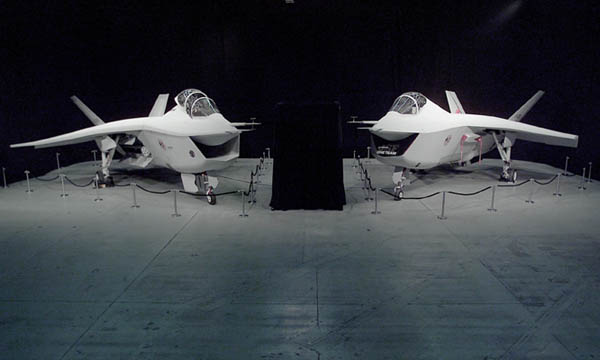
The ceremony marked the completion of assembly of both aircraft before they transition
to the flight-test phase of the program in early 2000.
Boeing implemented a number of "lean" concepts, including advanced 3-D solid modeling and minimal tooling,
to design and build the X-32s in less the time and at less cost than comparable aircraft.
The X-32A(left) will demonstrate conventional takeoff and landing for the U.S. Air Force and carrier-approach
flying qualities for the U.S. Navy.
The X-32B(right) will demonstrate short takeoff/vertical landing requirements for the U.S. Marine Corps
and the U.K. Royal Air Force and Royal Navy.
First flight is on schedule for spring and summer 2000, respectively.
SEATTLE
Artist's rendition of the Boeing Joint Strike Fighter 737-200 Avionics Flying Laboratory.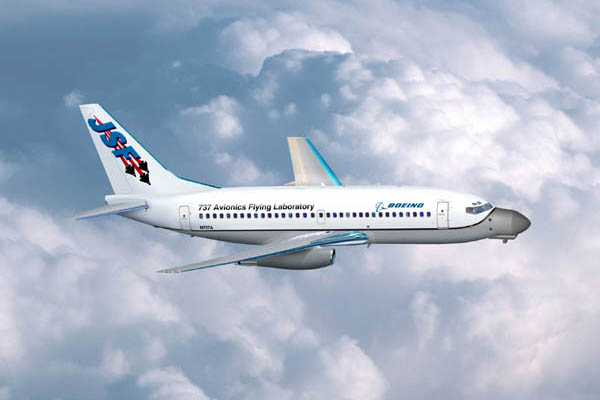
The U.S. Marine Corps variant of the Boeing Joint Strike Fighter preferred weapons system concept.
JSF IN THE FUTURE
Flight evaluation of the demonstrator aircraft is to take place in 2000.
One of the two consortia will then be selected in 2001 for the development and manufacture of all three variants.
JSF is expected to enter service in 2008.
PROPULSION
All three variants for both Lockheed Martin and Boeing teams are powered by
the Pratt and Whitney afterburning turbofan JSF119-611 engine, a derivative of the F119 fitted on the F-22.
Boeing’s 119-614 and Lockheed Martin’s 119-611 engines share a common core
(compressor, combustor and high pressure turbine), but low pressure turbines, nozzles
and additional components for the STOVL variants are adapted for the requirements of each team’s design.
LOCKHEED MARTIN JSF (X-35)
The Lockheed Martin JSF team includes Northrop Grumman, Pratt and Whitney, Rolls-Royce and BAE SYSTEMS.
The first flight engine was installed in the X-35A demonstrator in December 1999.
The canopy, radar and most of the avionics are common to the three variants.
Systems will include:
Northrop Grumman advanced electronically scanned array radar,
Sanders/Litton Amecon electronic countermeasures equipment,
Lockheed Martin electro-optical targeting system,
Northrop Grumman DAIRS (Distributed Aperture Infrared Sensor) thermal imaging system
and Vision Systems International (a partnership between Kaiser Electronics and Elbit of Israel)
advanced helmet-mounted display.
To minimise radar signature, sweep angles are identical for the leading and trailing edges of the wing and tail
(planform alignment). The fuselage and canopy have sloping sides.
The seam of the canopy and the weapon bay doors are sawtoothed and the vertical tails are canted at an angle.
The air force variant has an internally mounted gun, infrared sensors and laser designator.
For the STOVL variant, a lift fan arrangement has been developed by Rolls Royce Defence North America
(formerly Allison) and the engine has a three bearing swivelling exhaust nozzle.
The Marine variant has no internal gun but an external gun can be fitted.
The internal structure of the carrier-based naval version is strengthened for carrier landings.
Larger leading edge flaps and foldable wingtip sections provide a larger wing area for improved control.
The aircraft has an internally mounted gun and laser designator.
BOEING JSF (X-32)
Boeing's team includes:
Raytheon, Pratt &Whitney, Rolls Royce, Messier-Dowty, BAE SYSTEMS and Flight Refuelling Ltd.
Final assembly of the X-32A (USAF and USN carrier variant)
began in March 1999 and has successfully completed structural proof testing.
X32B (STOVL variant) is based on the established Rolls Royce direct lift concept currently used in the
Harrier aircraft of the USMC and UK Royal Navy.
Boeing completed the final design review of the X-32 demonstrators and made some design alterations
to the basic flight qualities.
These include a refined empennage with horizontal tails for additional control power;
a modification to the wing's trailing edge while retaining the same high leading edge sweep of the delta wing,
and an aft-swept chin inlet.
Both demonstrators were shown by Boeing for the first time in December 1999.
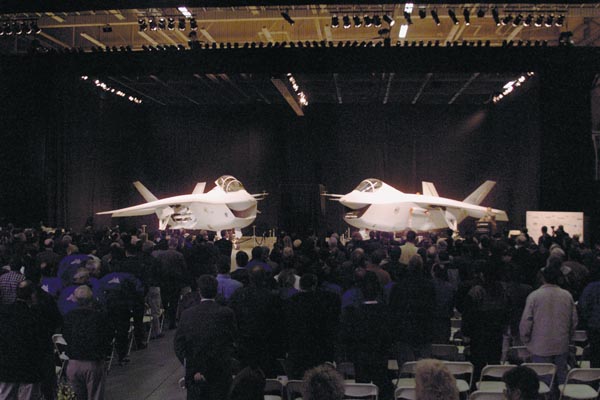
The gun system for the Boeing JSF will be the Advanced 27 mm Cannon being developed by a team led by Boeing,
with Mauser-Werke of Germany and Primex Technologies and Western Design of USA.
The cannon is a single barrel, gas-operated lightweight revolver gun that fires electrically-primed ammunition
at 1800 shots per minute.
